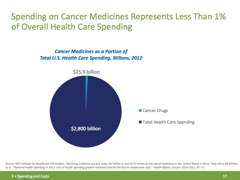
Focusing on Only 1% of Spending Will Not Solve Nationís Health Care Challenges
Print
29 July 2015
Robert Zirkelbach / PhRMA
Commentary published today in Mayo Clinic Proceedingshighlights a critical challenge facing cancer patients: the ability to access the medicines they need. But rather than address this issue directly, the authors outlined a series of proposals that focus solely on the 1 percent of health care spending that goes toward life-saving cancer medicines. And the article ignores the fact that cancer medicines represent only one-fifth of total spending on cancer treatment. The policy proposals they recommend would, if adopted, send a chilling signal to the marketplace that risk-taking will no longer be rewarded, stopping innovation in its tracks and halting decades of progress in cancer care.
Despite representing such a small share of spending, oncology medicines are often singled out by insurers for high cost sharing and additional restrictions on access. This violates the basic purpose of insurance, and is why improving coverage for medicines needs to be a top priority for policymakers. At the same time, we continue to work directly with patients to help them get access to the medicines they need.
The fight against cancer is just beginning. And to ensure that innovation continues, discussions about the cost of cancer medicines needs to consider the following:
- The pipeline has never been more promising. In the last several decades, our scientific understanding of cancer has grown exponentially. Today, there are almost 14 million cancer survivors in the U.S. and the chances that a cancer patient will live five years or more has increased by 39 percent across all cancers. And the more than 800 oncology medicines in the pipeline in the U.S. have the potential to completely transform cancer treatment and dramatically improve the lives of patients.
- The science is hard and keeps getting harder. There are more than 200 unique sub-diseases that fall under the umbrella of "cancer," and each one may differ depending on the patient’s unique characteristics. The odds of success are low with only 12 percent of medicines entering clinical trials ever making it to the market. And the challenge continues to grow as scientists increasingly target medicines to individual patients. For example, 73 percent of cancer medicines in the pipeline have the potential to be personalized medicines.
- The unique marketplace for medicines helps keep spending in check. The public policy debate has been plagued by a fundamental lack of understanding of how the marketplace for medicines actually works. Insurers and pharmacy benefits managers (PBMs) aggressively negotiate prices and use their clout to incentivize use of the lowest cost options. And eventually, all of these medicines will come off patent and face additional competition from lower-cost alternatives. This dynamic is why the share of health care spending going towards cancer medicines has remained consistent for decades.
Learn more about how the Partnership for Prescription Assistance (PPA) connects uninsured or underinsured Americans to programs that provide prescription medicines for free or nearly free here.
All Portfolio
MEDIA CENTER
-
The RMI group has completed sertain projects
The RMI Group has exited from the capital of portfolio companies:
Marinus Pharmaceuticals, Inc.,
Syndax Pharmaceuticals, Inc.,
Atea Pharmaceuticals, Inc.


